AdClarity — Advertising Intelligence is a competitive intelligence app created by BIScience, which collects, analyzes, and aggregates real-time display, video, and social ad occurrences across 650 thousand publishers from 51 global markets. Markets include the United States, Europe, Latin America, the Middle East, and Asia-Pacific. AdClarity — Advertising Intelligence can be found in the Semrush App Center.
How Can AdClarity — Advertising Intelligence Help Me?
AdClarity — Advertising Intelligence’s competitive advertising intelligence can help you:
- Analyze competitors’ digital campaigns
- Identify the best-performing publishers, advertisers, ad networks, and agencies
- Benchmark your online advertising against the competition
- Leverage data-driven insights to engage and deploy online campaigns more effectively
Pricing
AdClarity - Advertising Intelligence has 2 in-app package options: AdClarity Display and AdClarity Social & Video.
- The cost for AdClarity Display in-app is $169 per month
- The cost for AdClarity Social & Video in-app is $180 per month
- The cost of All Advertising Channels (AdClarity Display + AdClarity Social & Video) is $349 per month
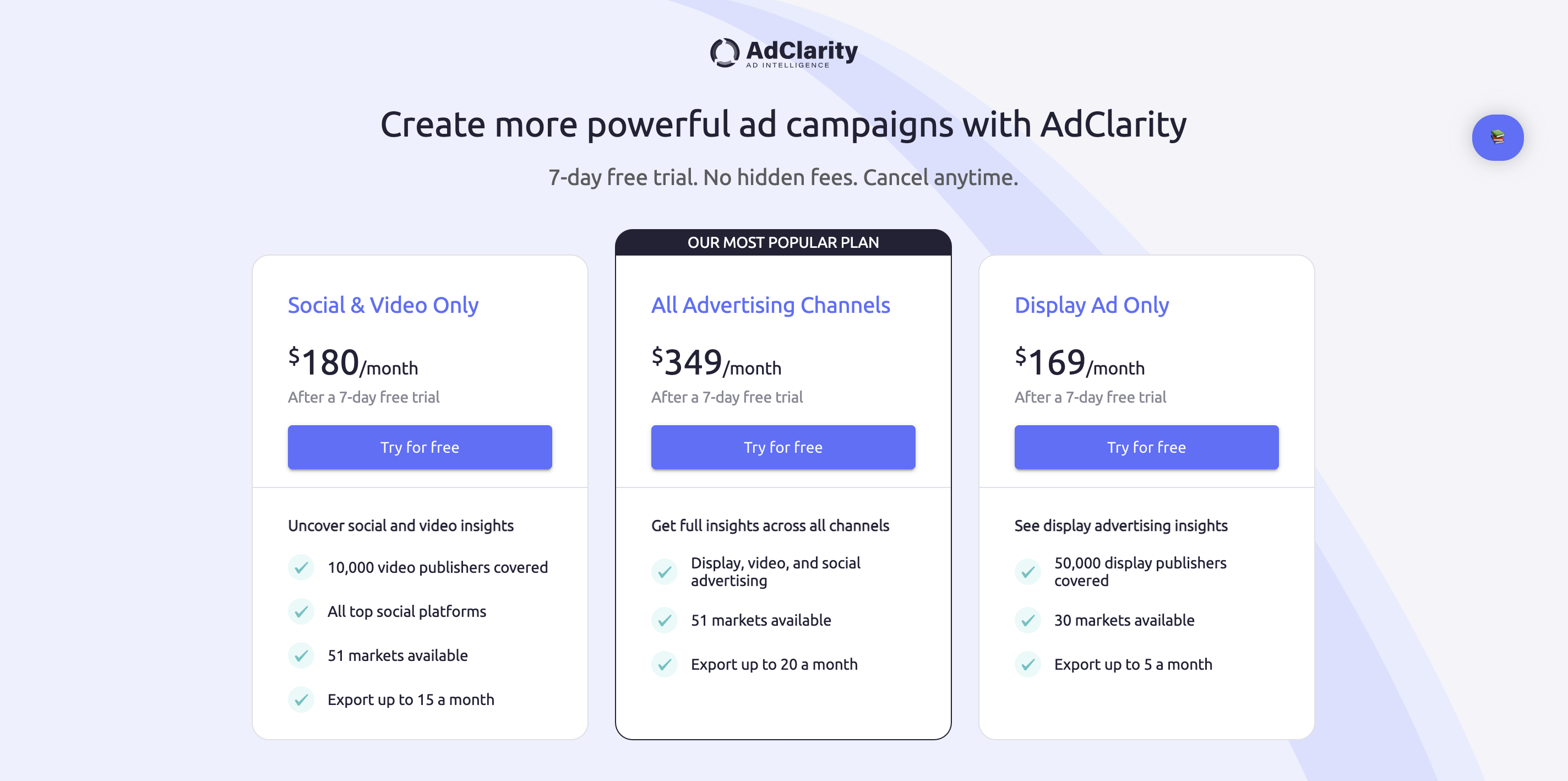
Learn more about Semrush subscription plans pricing and apps pricing.
What Is Included in AdClarity — Advertising Intelligence
AdClarity — Advertising Intelligence analyzes expenditure, placement, buying methods, and more, for image ads, animated ads, rich media ads, skin ads, video, and social ads across 650 thousand publishers in 51 global markets.
There are two packages available for AdClarity users. You can either use each separately or two at the same time, depending on your needs.
AdClarity Display helps you discover display advertising insights. With it, you’ll have access to the Display channel data with 50,000 display ads publishers and 30 countries covered, with 5 report exports per month.
- Argentina
- Australia
- Belgium
- Brazil
- Canada
- Denmark
- Finland
- France
- Germany
- Hong Kong
- India
- Indonesia
- Italy
- Japan
- Mexico
- Netherlands
- New Zealand
- Norway
- Philippines
- Puerto Rico
- Russia
- Singapore
- South Africa
- Spain
- Sweden
- Switzerland
- Taiwan
- United Kingdom
- United States
- Vietnam
AdClarity Social & Video helps you discover insights for social media and video ads. With it, you’ll have access to Social and Video channels’ data across 51 countries and 15 report exports per month.
The Video channel provides data for 10,000 video ads publishers, including Youtube.
The Social channel provides data from all top social media networks: Facebook, Twitter, Instagram, TikTok, Pinterest, and LinkedIn.
User Settings
At the top-right corner of the app interface, you’ll be able to access User settings.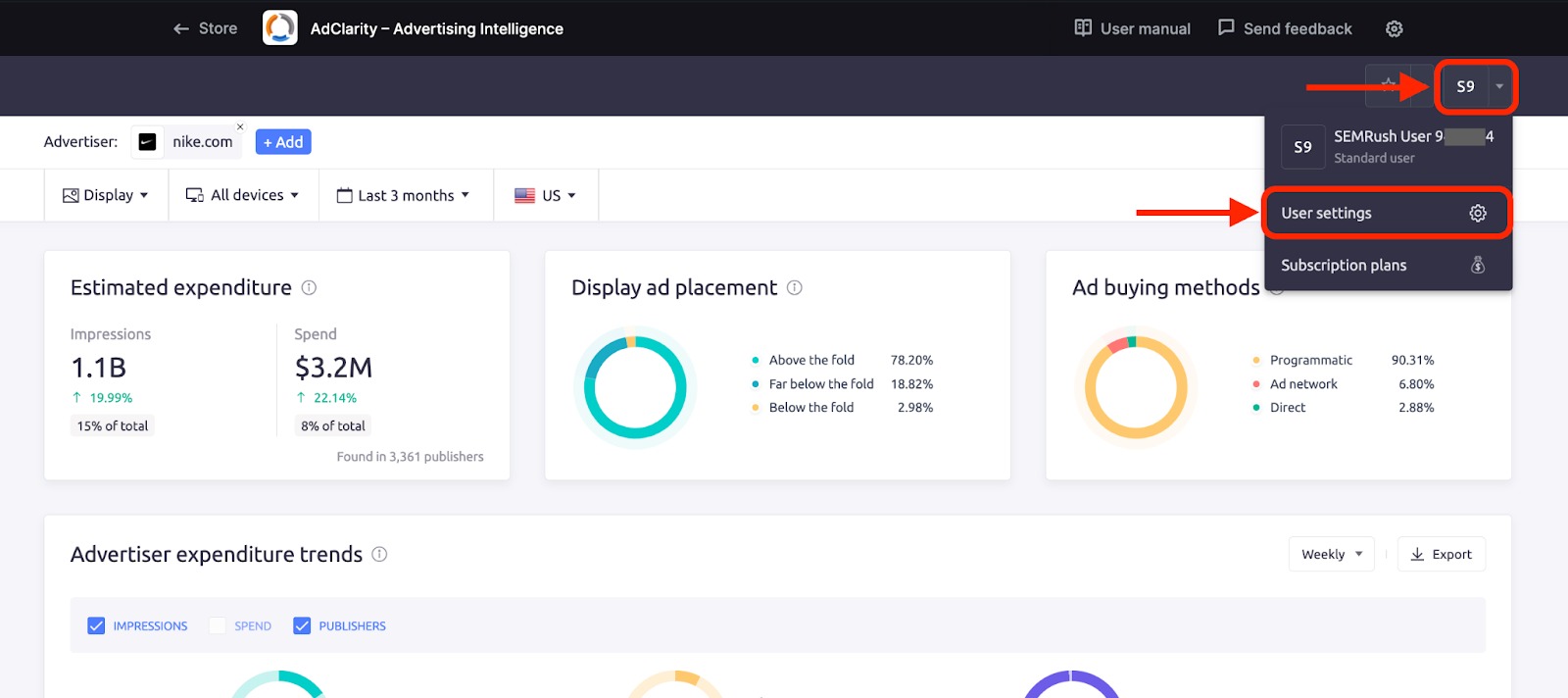
There you’ll be able to set up, the following:
Default currency - choose which currency is displayed in cost estimation widgets.
Default metrics - choose if you wish related widgets to display numbers, percentages, or both.
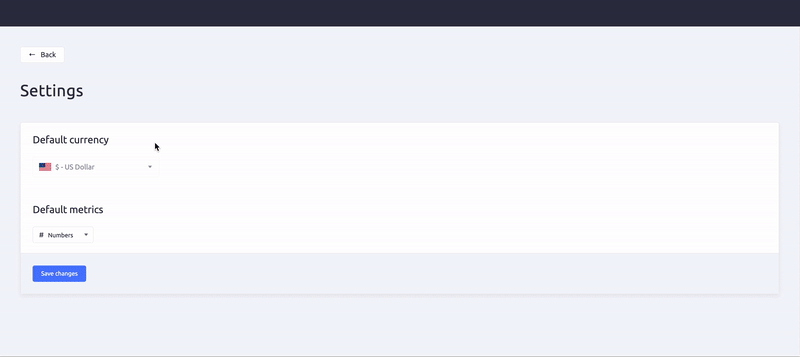
Setting Up Your Report
You can start setting up your report using the header at the top of the screen:

Using the search bar at the top of the header, you can search for a domain you’d like to analyze. Click “add” to search for it by name, without the “www.” Then click on the matching search result to select it.
If you don’t see any results, double-check how you’ve typed the domain:
- semrush.com: This version is correct
- www.semrush.com: This version is incorrect
- https://www.semrush.com: This version is also incorrect
If you want to view more than one domain, you have two options:
- Group: View consolidated data for all of your selected domains.
- Compare: Analyze up to 10 selected domains or groups against one another.
To create a group, simply click “add” in the search bar and search for each domain you want to include.

To compare domains, click the “compare” button on the right to select your domains.
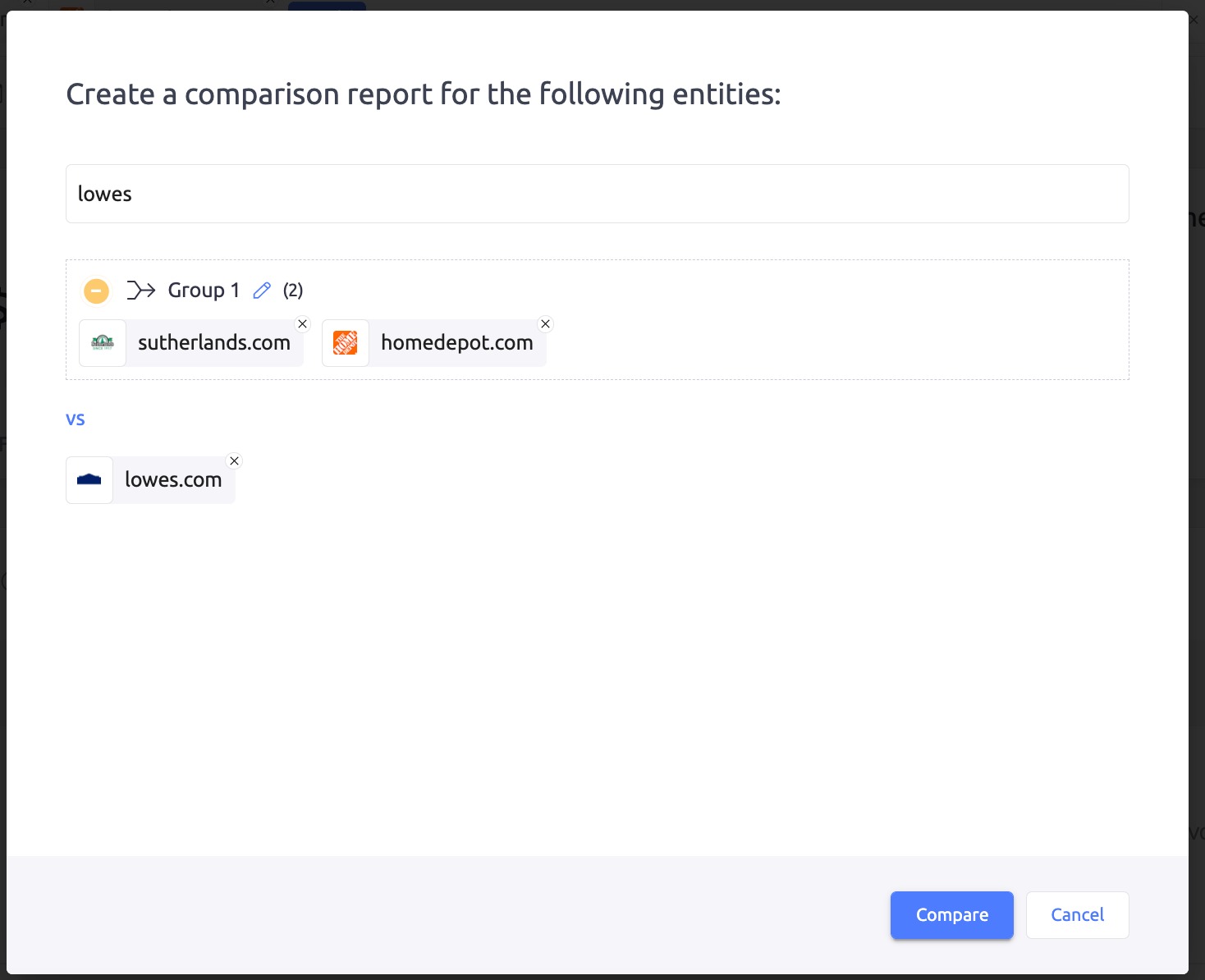
To edit your comparison, click the blue “rearrange” button on the right.

This will return you to the “create a comparison report” window pictured above. Here, you can add additional domains or groups to your report or click and drag them to rearrange them.
To save a group or comparison, click the blue “save” button on the right side of the search bar and assign it a name when prompted. Data saved as a group will be merged together, whereas saving a comparison will maintain separate data for each domain.
On the second row of the header menu, you can further customize your view by selecting your preferred channel, devices, time period, and change country being analyzed.

The channels dropdown allows you to filter by the advertising channel want to advertise, including:
- All channels
- Display
- Video
- Social

For display and video channels, you may also select a device type:
- All devices: Analyzing all instances of display ads regardless of device type.
- Desktop: Analyzing only ads that appeared on desktop browsing.
- Mobile: Analyzing only ads that appeared on mobile devices and browsers.
Next, you may choose to view data from time periods including the last 7 days, 30 days, 3 months, 12 months, or the current year to date.
You may also customize your view by location. In the example above, ad instances shown in the United States are being analyzed. Click the drop-down arrow to select a different location. You may view one of up to 51 different countries around the world. However, depending on the domain being analyzed, not all countries may be available.
Exporting Your Report
To export your report, click on the "Export" button. It can be found on the right side of the header, in the second row.

Next, select the file type you want to export:
- PDF: Exports all charts and graphs as displayed in the app
- Excel: Exports a spreadsheet containing the data shown in the report
If you have an AdClarity — Advertising Intelligence subscription that includes only the display channel, you may export five excel reports per month. If you’ve added both the Display and the Social & Video subscriptions, you may export up to 20 excel reports per month. PDF reports are currently unlimited.
Report Types
AdClarity — Advertising Intelligence offers four different report types:
- Publisher reports
- Advertiser reports
- Campaign reports
- Keywords reports
Additionally, users can compare publishers and advertisers against one another, and create groups to consolidate data.
Each report shares many of the same widgets, while analyzing different sets of data.
Publisher vs. Advertiser Reports
The Publisher report analyzes the placement and performance of ads published on a specified domain or app, and compares the performance of ads published on multiple specified publisher domains. As such, this report will provide data about the ads and advertisers published on the domains in question. “Publisher” here refers to a domain or app that displays an ad for a third party (the advertiser).
Meanwhile, the Advertiser report analyzes the performance of a specified advertiser’s ad placement across all publishers, and compares the performance of multiple advertisers across all publishers. As such, many of the widgets in this report contain information about publisher performance with respect to the advertisers in question. Here, “Advertiser” refers to any organization whose ads are being displayed on third-party “publisher” domains.
Campaign Reports
Campaign reports analyze the performance of a specific campaign. A campaign is a group of coordinated ads all leading to the same landing page.
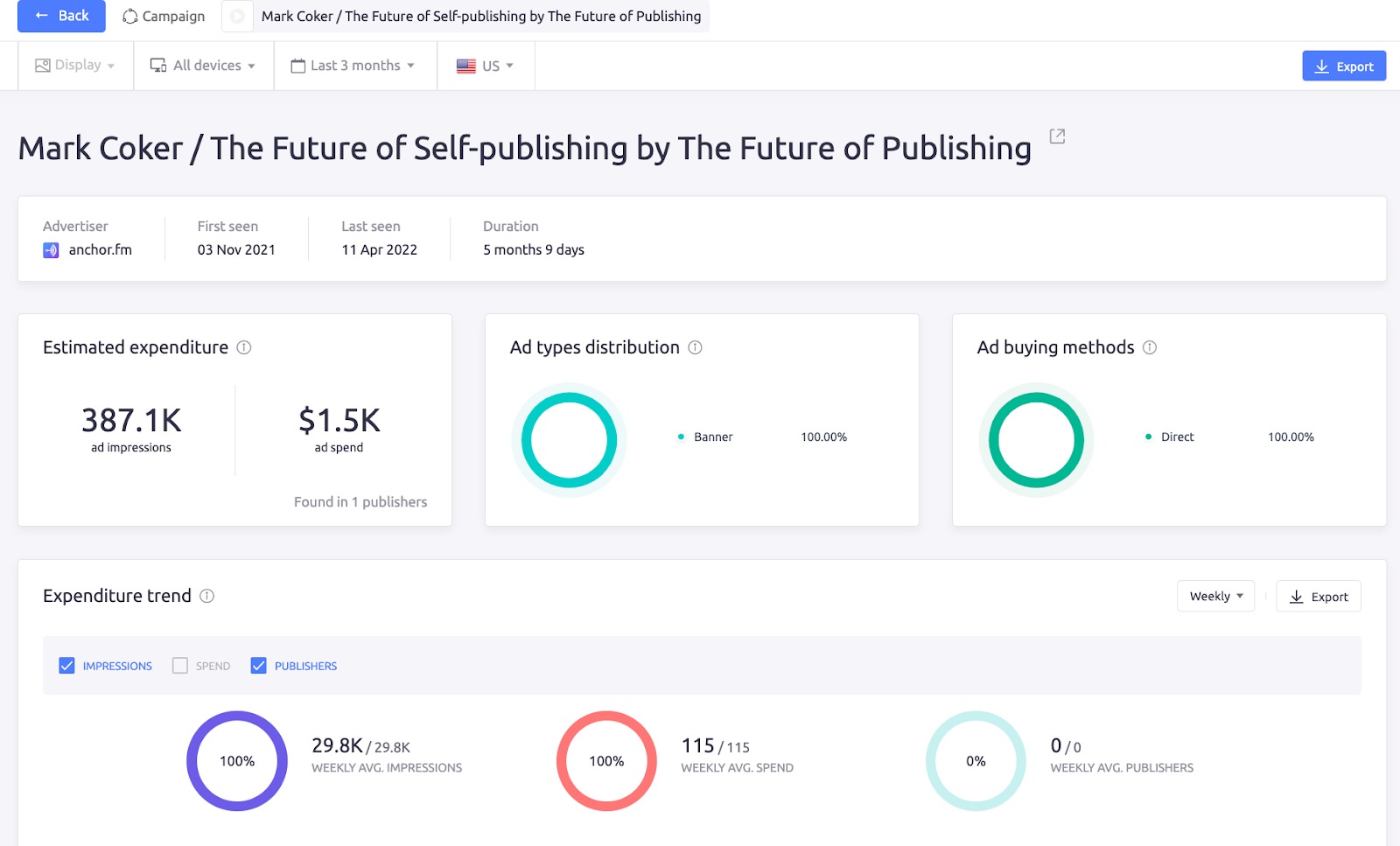
You can access the campaign report via the Top Campaigns widget, by clicking on the name of a campaign you want to analyze.
In the campaign report header, you can find:
- The advertiser running the campaign
- The first and last seen dates
- Campaign duration
The body of the report uses the same widgets described below in the Widgets Guide section. The chief difference is that, in this report, the widgets use data only pertaining to this specific set of ads.
Keywords Report
The Keyword report analyzes campaigns based on search terms. In this report you will find:
- The number of campaigns
- The Top Ads
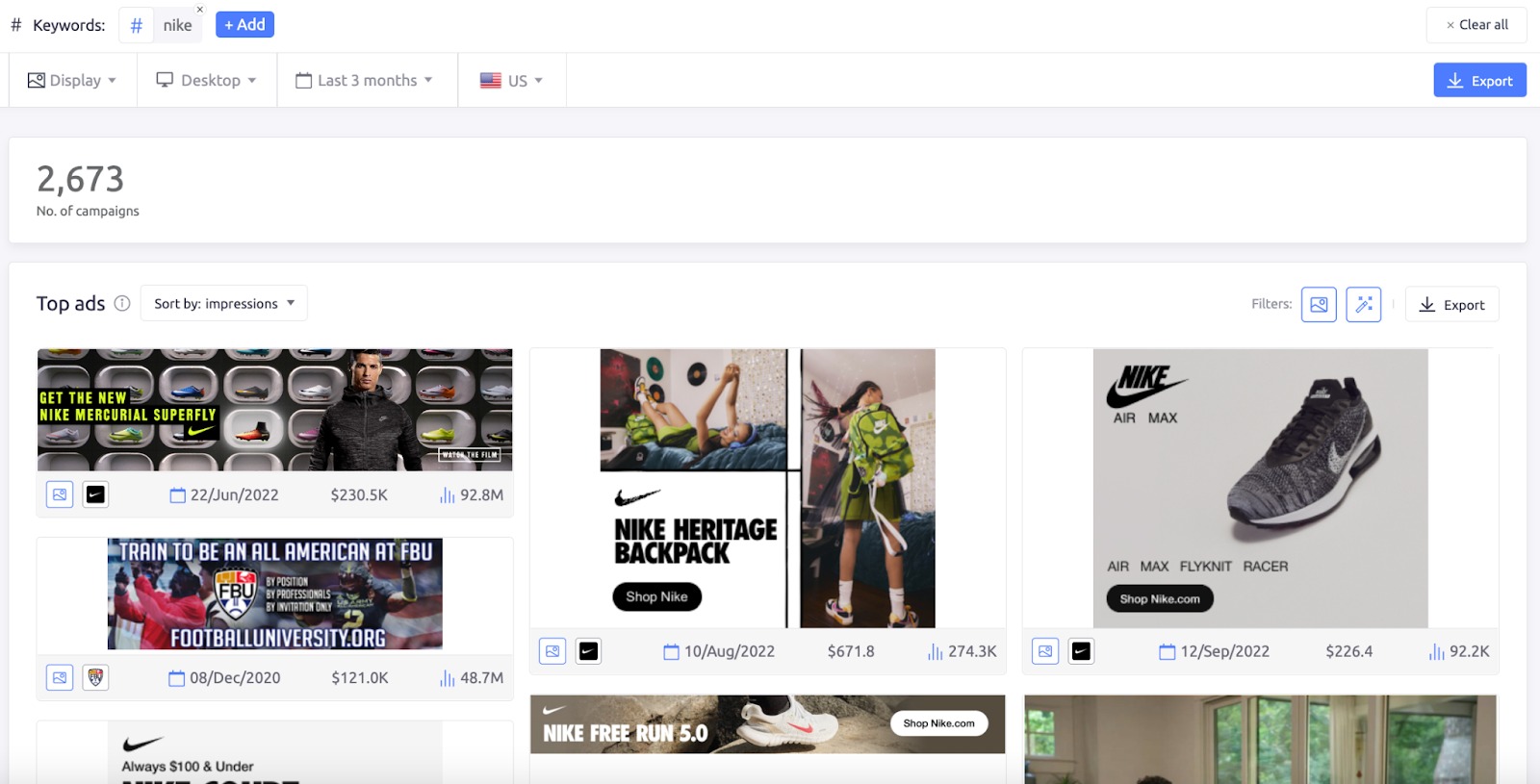
Single Domain vs. Multiple Domain Comparison Mode
The widgets that appear in your report may vary, depending on:
- Whether you’re viewing a single domain or comparing several
- Which advertising channels you’re viewing
- Whether you’re viewing an advertiser or publisher
Here is a breakdown of which widgets you can expect to find:
|
Single Domain Report |
Multiple Domain Comparison Report |
Widgets Guide
Below is a guide to all of the widgets you can expect to find in AdClarity — Advertising Intelligence app. Please note that not all widgets may appear in every view. See the Single Domain vs. Multiple Domain Comparison chart above for a complete breakdown.
Estimated Expenditure
The Estimated Expenditure widget appears at the top left of both publisher and advertiser reports when you are analyzing a single domain or group. If you’re comparing multiple domains, you will instead see the Publisher or Advertiser Distribution widget.
In an advertiser report, Estimated Expenditure shows the total impressions (on the left) and ad spend (on the right) across all publishers.
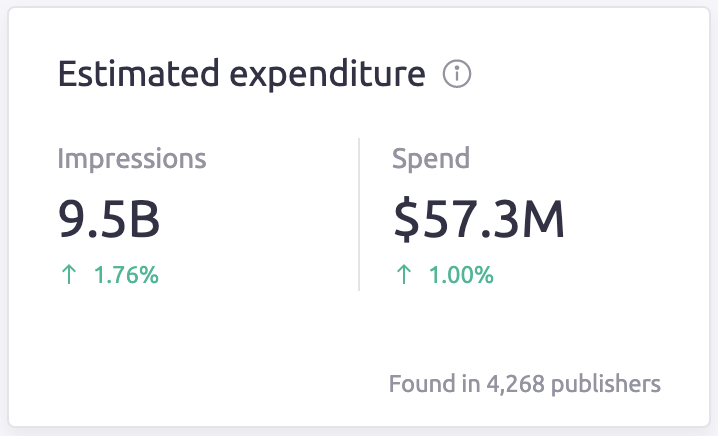
If you are viewing all channels, the widget appears as shown above. If you are only viewing a single channel (e.g., display ads), the widget will also show you that channel’s share of impressions and spend.
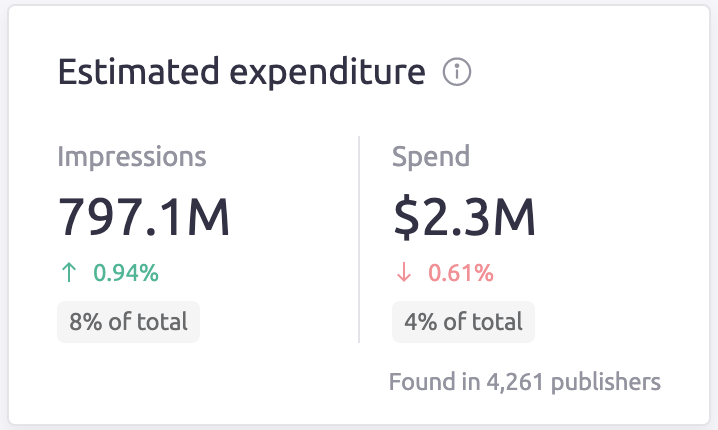
Please note that these figures are determined by your selected channel, domains, device type, period, and country. Any updates to these selections will change the estimated expenditure.
The number of publishers contributing to these estimates can be found in the bottom right corner of the widget. If you click on this number, you’ll be taken down the page to the Top Publishers widget for a more detailed breakdown.
Here is an example of what this widget looks like when viewing a publisher:
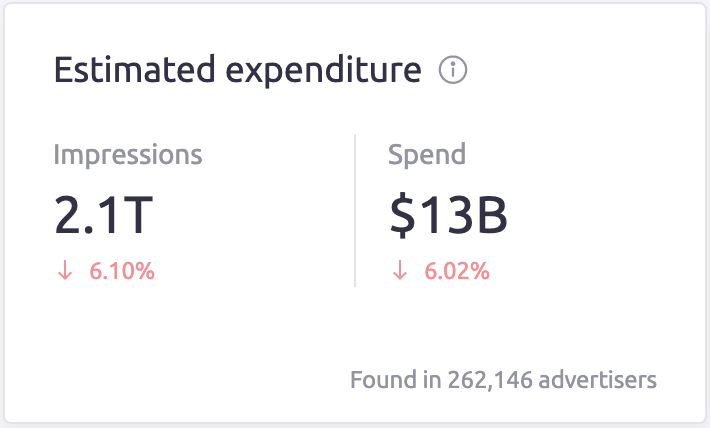
For publisher domains, Estimated Expenditure shows the total impressions generated by all ads placed on that domain. Ad spend refers to the amount spent by advertisers to buy ad placement on the publisher domain. Clicking the “Found in # advertisers” link will take you to the Top Advertisers widget.
If you select a period of 2 months or more, then the widget also displays a Month-over-Month change (MoM change) metric below the total impressions and ad spend figures. This metric is great for checking recent impressions and ad spend trends at a glance.
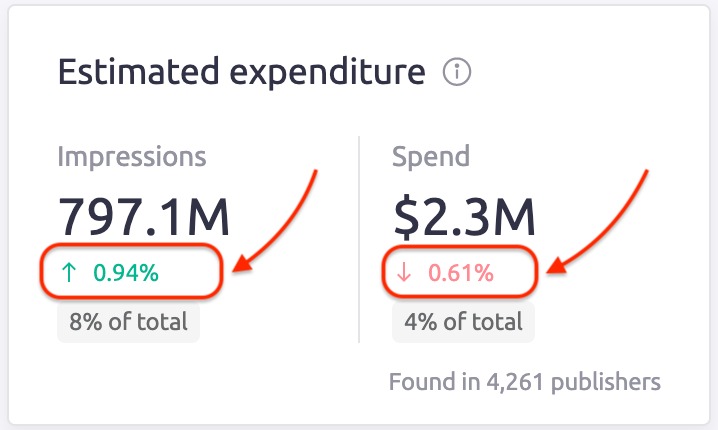
If there was a decline in estimated impressions or expenditure compared to the previous month, the change would be displayed in red with an arrow pointing down, and if there was an increase, the number would be displayed in green with the arrow pointing up.
Ad Types Distribution
The Ad Types Distribution widget appears when you analyze a single advertiser domain for the following channels:
- All channels
- Social
This widget shows how many of each type of ads an advertiser runs during the analyzed period.
When viewing all channels, that includes video, banner, and social ads.
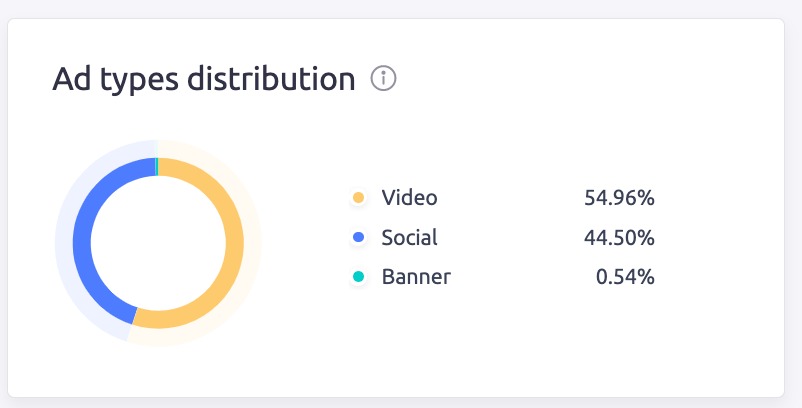
When viewing the social channel, this widget is called Social Ad Types, and includes:
- Image ads
- Video ads
- Carousel ads
- Promoted accounts

Ad Placement
The Ad Placement widget appears when you analyze a single domain for the following channels:
- Display (called Display Ad Placement)
- Video (called Video Ad Placement)
- Social (called Social Ad Placements)
When viewing the Display or Video channels, you’ll find the widget in the top center, to the right of Estimated Expenditure. When viewing the social channel, you’ll find it on the top right.
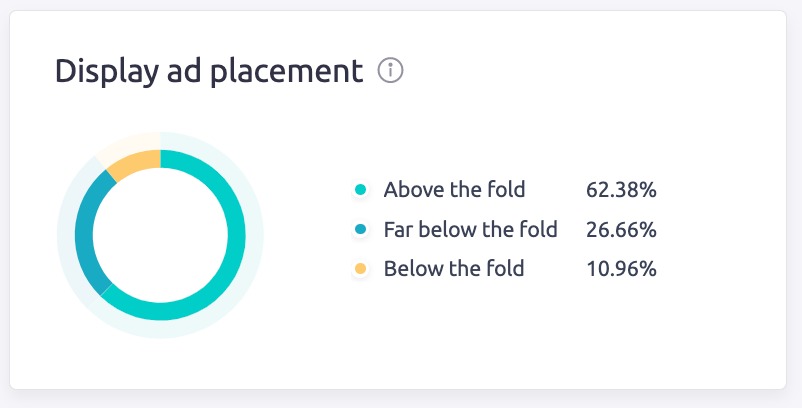
Display Ad Placement analyzes where display ads were placed on the screen when they occurred. Options include:
- Above the fold: Ads visible on a user’s screen without scrolling.
- Below the fold: Ads the user would need to scroll in order to see.
- Far below the fold: Ads placed at or near the bottom of the page.

Video Ad Placement shows you where in a video the ad appears:
- Pre-roll: before a video begins
- Mid-roll: during a video
- Post-roll: at the end of a video
- Masthead: on top of a video page
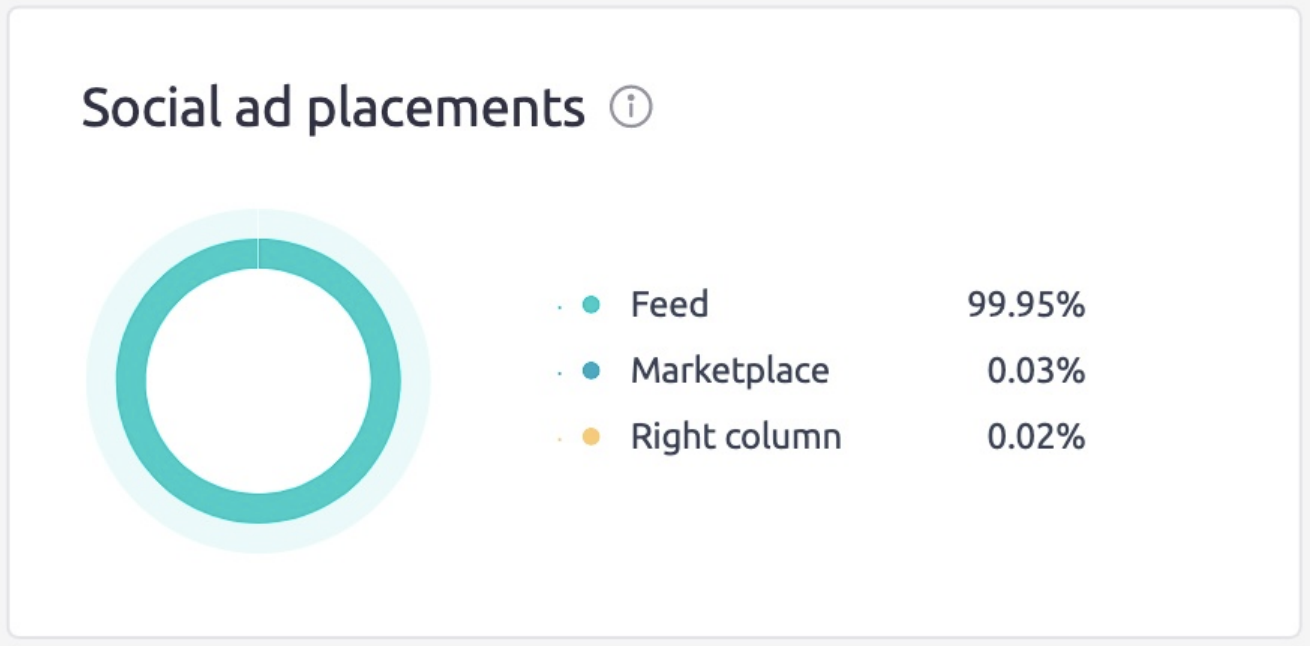
Social ad placements shows where on a social platform an ad was placed (e.g. in the feed, in a column to the right, or in the marketplace). As such, the options included may vary depending on the social platforms used and the available data for those ads.
This widget’s functionality is essentially the same for both publishers and advertisers, though it analyzes slightly different data:
- Advertiser view: Breaks down the placement of selected advertisers’ display ads across many publishers.
- Publisher view: Breaks down the placement of ads from many advertisers on selected publisher domains.
Ad Buying Methods (Light)
When analyzing a single domain, Ad Buying Methods appears to the right of the Ad Placement widget, for the following channels:
- All channels
- Display
- Video
This widget shows a high level overview of ad buying methods during the analyzed period. Buying methods are broken down into three categories:
- Ad Network: Ads that were bought via an Ad Network (such as Google Display Network) to be displayed on a variety of publisher domains.
- Programmatic: Ads that were purchased using an automated system, usually through an ad exchange.
- Direct: Ads that were bought directly through the publisher.
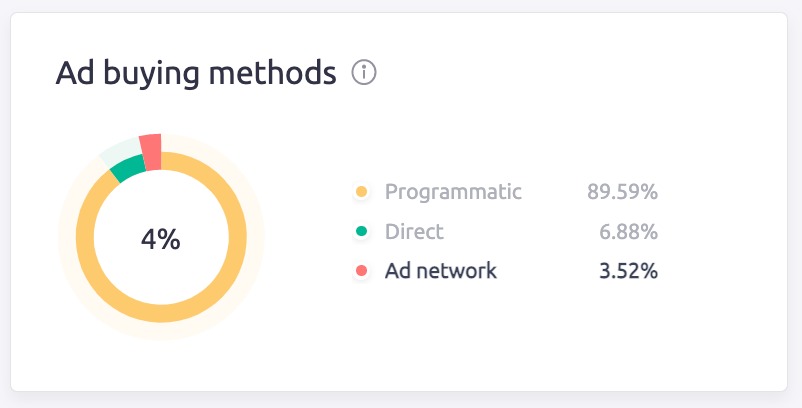
When viewing an advertiser, this widget analyzes all of the analyzed advertiser’s ads across all publishers. When viewing a publisher, it analyzes all ads displayed on the publisher domain, from all advertisers.
Estimated Impressions
When you are comparing multiple advertiser domains, the first widget you see is Estimated Impressions. This widget does not appear when analyzing publisher domains.
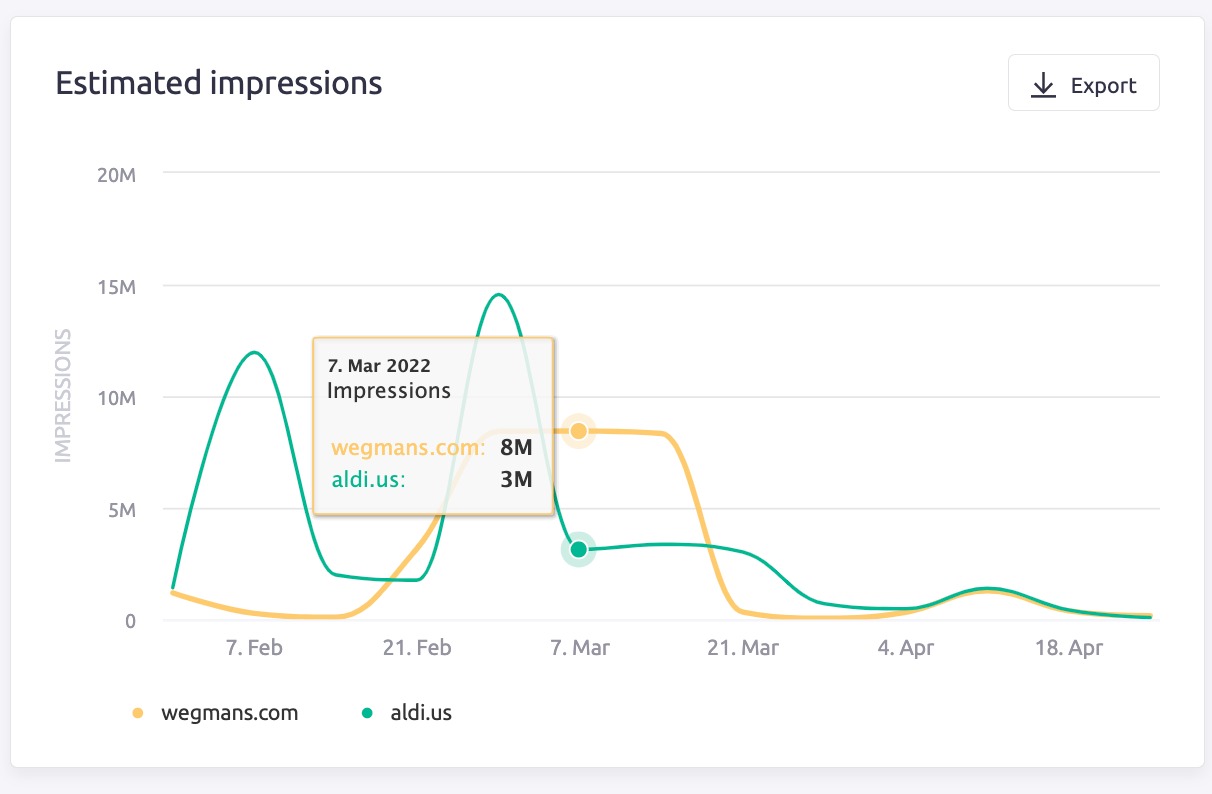
Estimated Impressions is a color-coded line graph that compares the trend of impressions generated by each advertiser (in the above example, grocery retailers Wegmans.com and Aldi.us) over the analyzed period.
For more information about the estimated impressions on a specific date, place your cursor over that spot on the graph.
Estimated Spend
When comparing two advertiser domains, the Estimated Spend widget can be found to the right of Estimated Impressions.
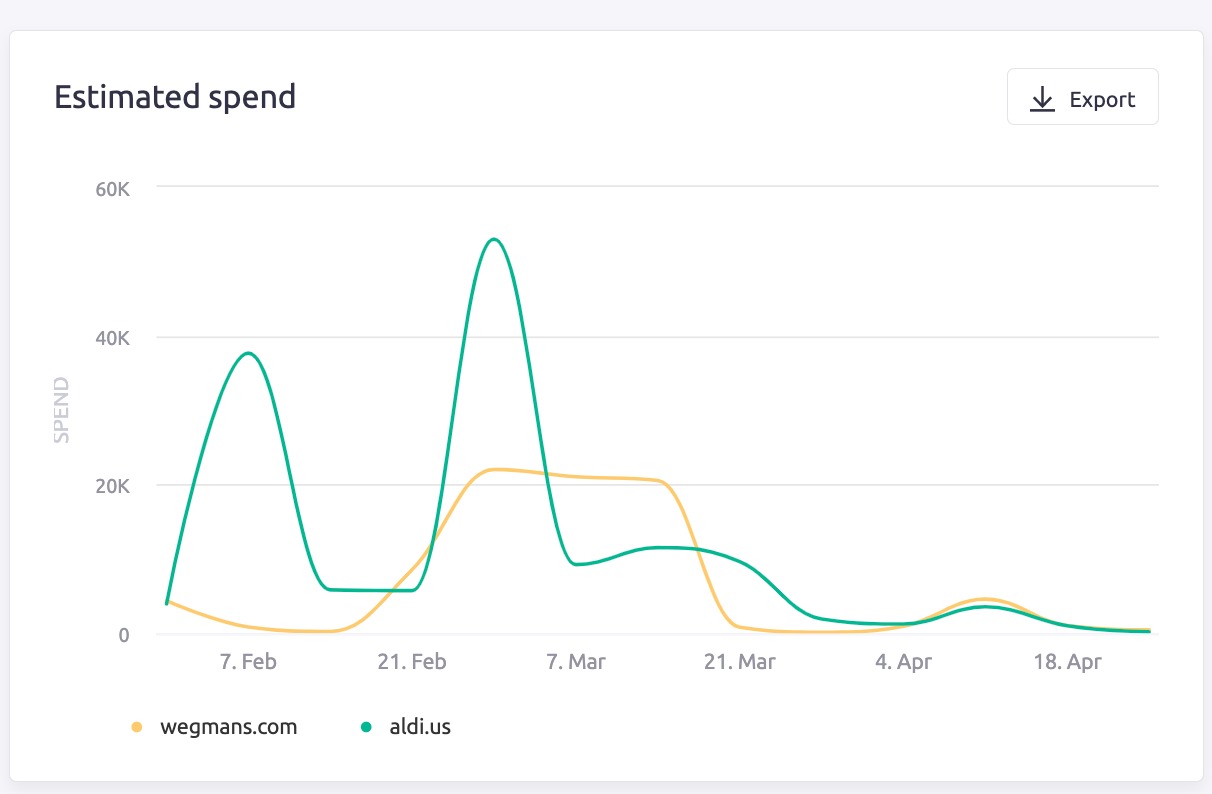
This widget uses color coded lines to depict the estimated ad spend for each advertiser over a specified period. To learn about a specific date, place your cursor over that spot on the graph.
Advertiser Distribution
When comparing publisher domains, the Advertiser Distribution widget can be found in the top row of the report. It uses color-coded line graph to compare the amount of advertisers who published ads on that domain during the analyzed period.

Highlights
The Highlights widget is visible in both the Advertiser and Publisher Overview reports when comparing multiple domains. It shows key information about the compared domains’ ad performance over the analyzed period:
- Estimated Impressions
- Spend
- Total Publishers or Advertisers
- Number of Unique Creatives.

To learn more about a specific advertiser or publisher, click on the domain in question and you will be taken to its respective Overview report.
Expenditure Trends
When analyzing a single domain, the Expenditure Trend widget can be found in the second row, in place of the Highlights widget. You can use this chart to view expenditure over a daily, weekly, or monthly period. Use the drop-down menu in the top right corner of the widget to change the period being viewed.
Expenditure trends can be shown in up to two of three possible dimensions:
- Average Impressions
- Average Spend
- Average Number of Publishers or Advertisers
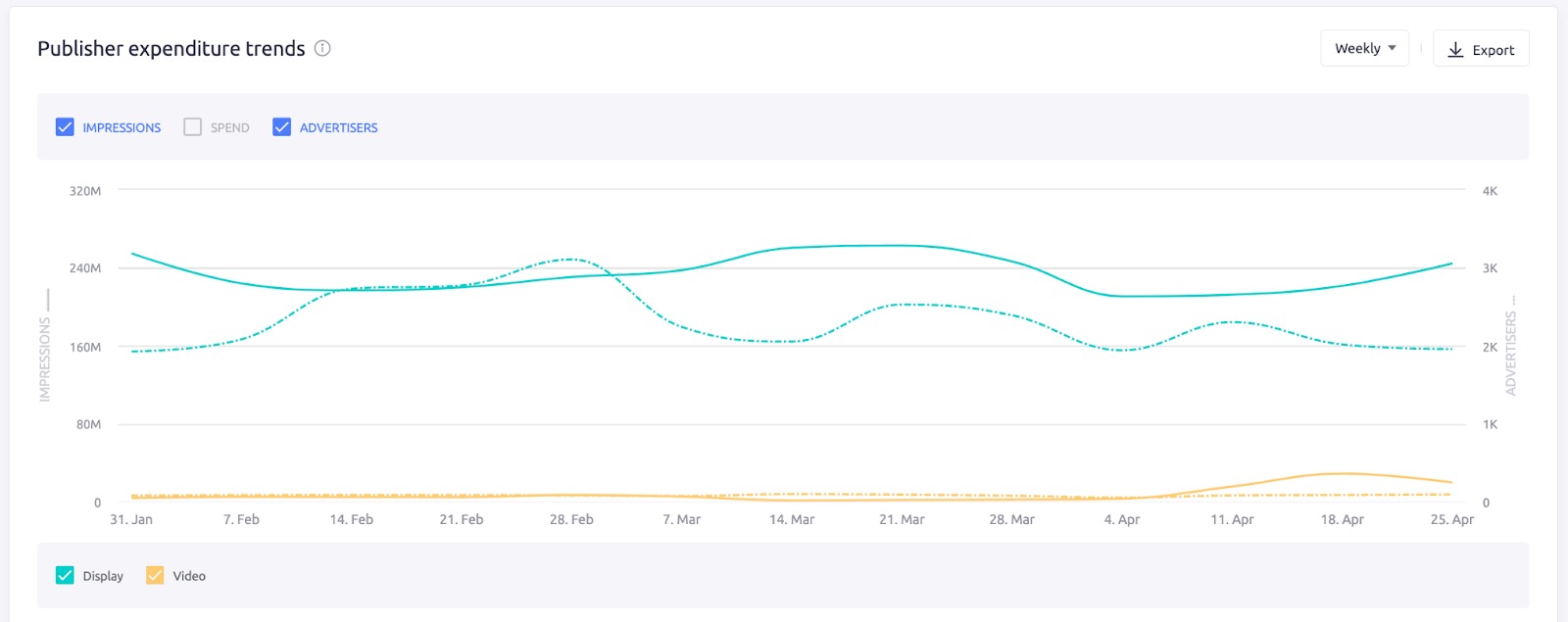
If you’re viewing all channels, this widget will also include an expenditure breakdown section directly below the trends chart.
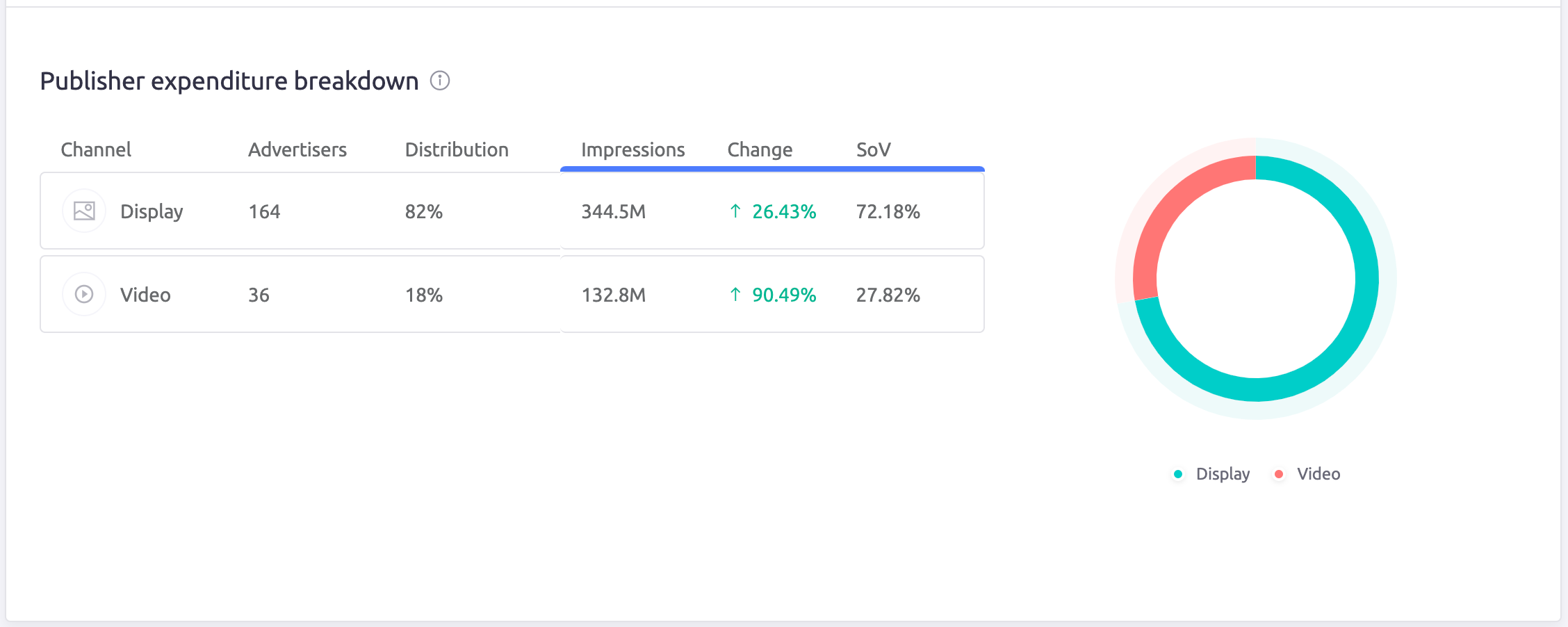
The expenditure breakdown section shows the expenditure for each channel that has data, plus that channel’s share of voice (SoV).
Top Ads
The Top Ads widget displays the top-performing ads from the selected domains. over the analyzed period. You can sort these by newest (based on last seen date), total impressions, and duration seen.
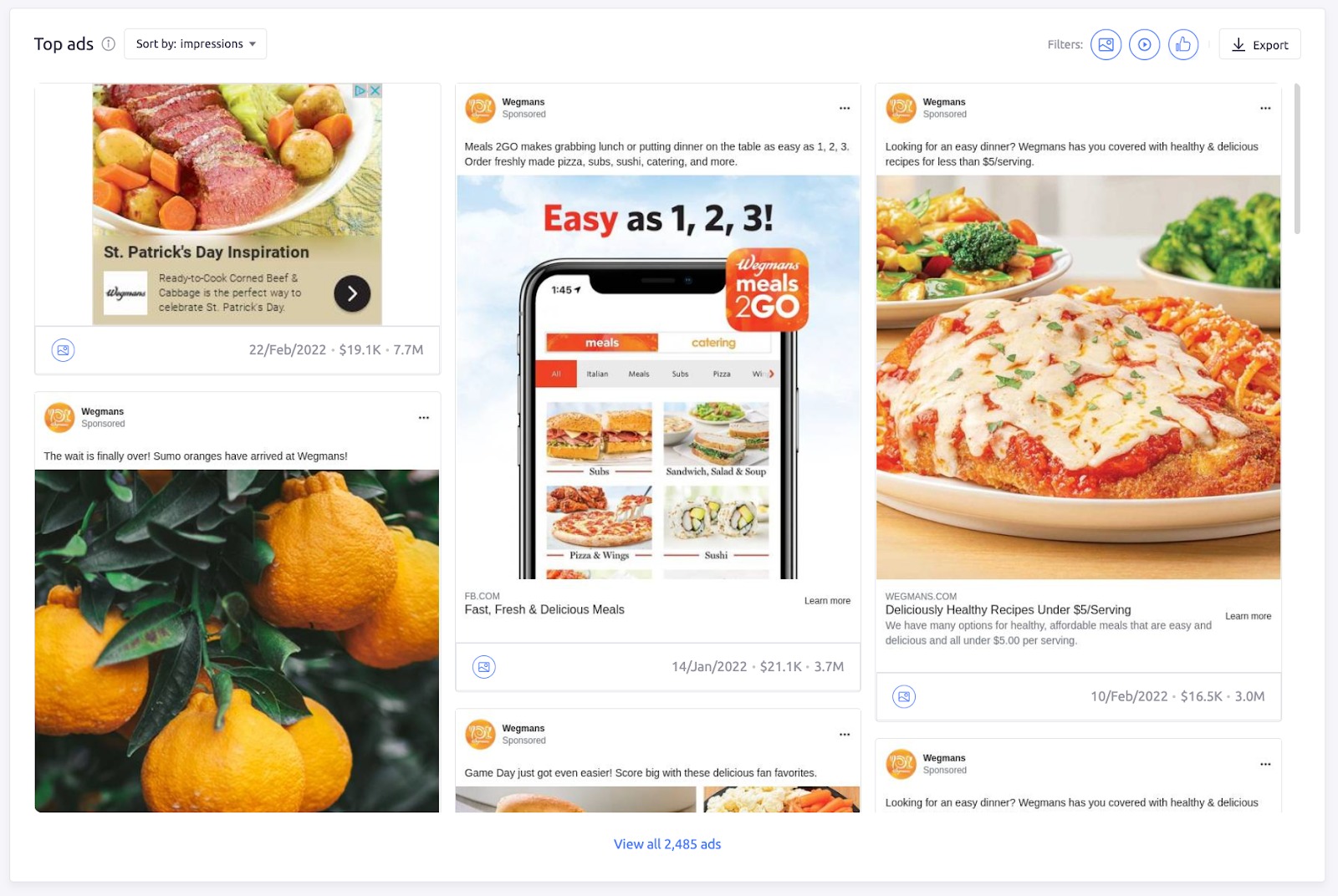
On the top right corner of the widget, you can find three filters, which you can use to exclude unwanted ad types:
- Hide banner ads
- Hide video ads
- Hide social ads
Click on one of these filters to narrow down your results.
To view more details about an ad, click on the image. A window will appear, showing you an expanded view of that ad, and other details such as:
- Type of Ad
- Dimensions
- Impressions
- Spend
- Publisher (Seen On)
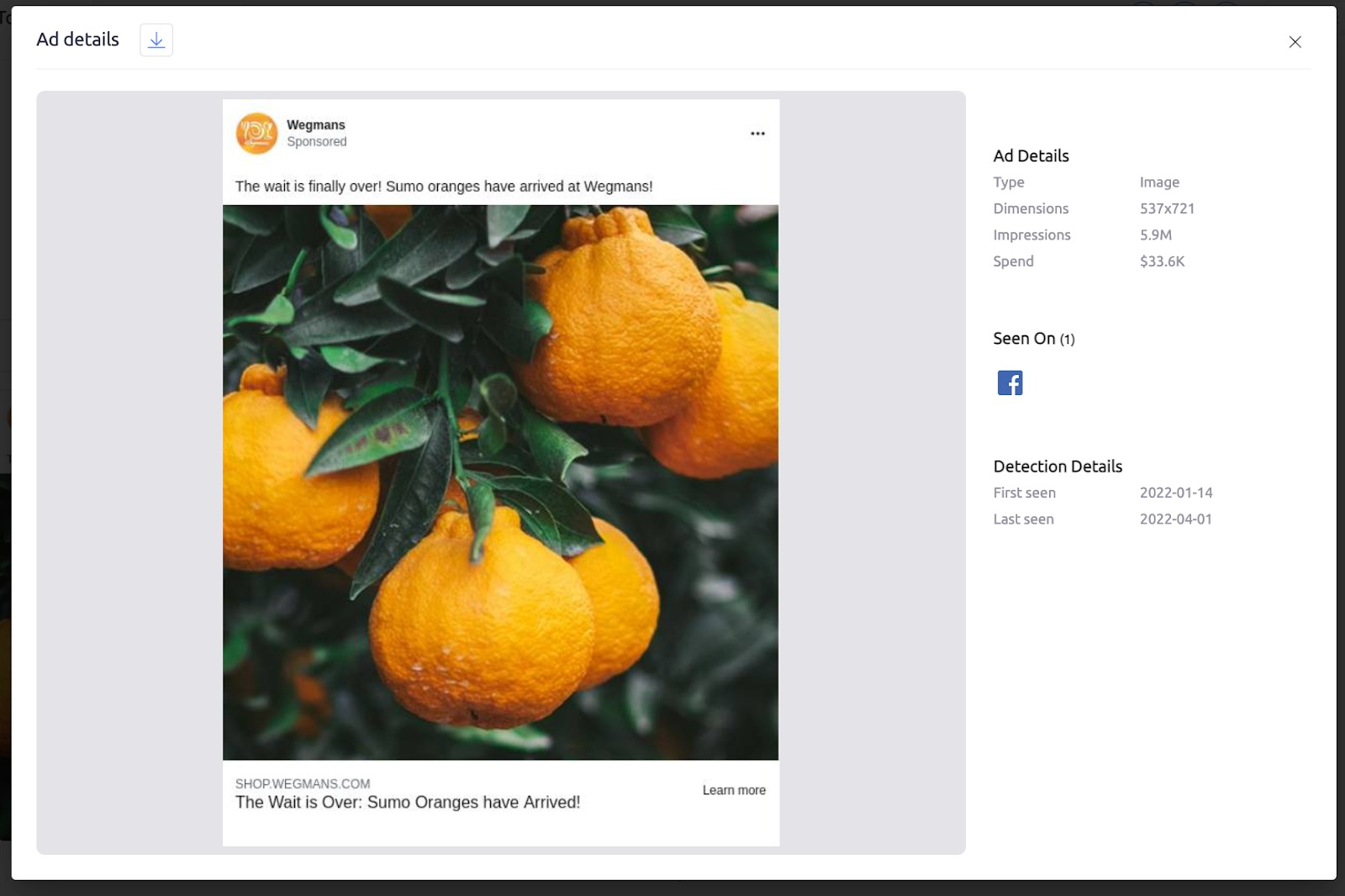
Top Campaigns
Available in all views, the Top Campaigns chart ranks the best-performing campaigns for the analyzed domains during a given period.
The first column on this chart is the name of the campaign. If you click on one of these, you will be taken to a campaign report for that campaign.
If you’re in Comparison Mode, the second column will tell you the relevant publisher or advertiser being compared.
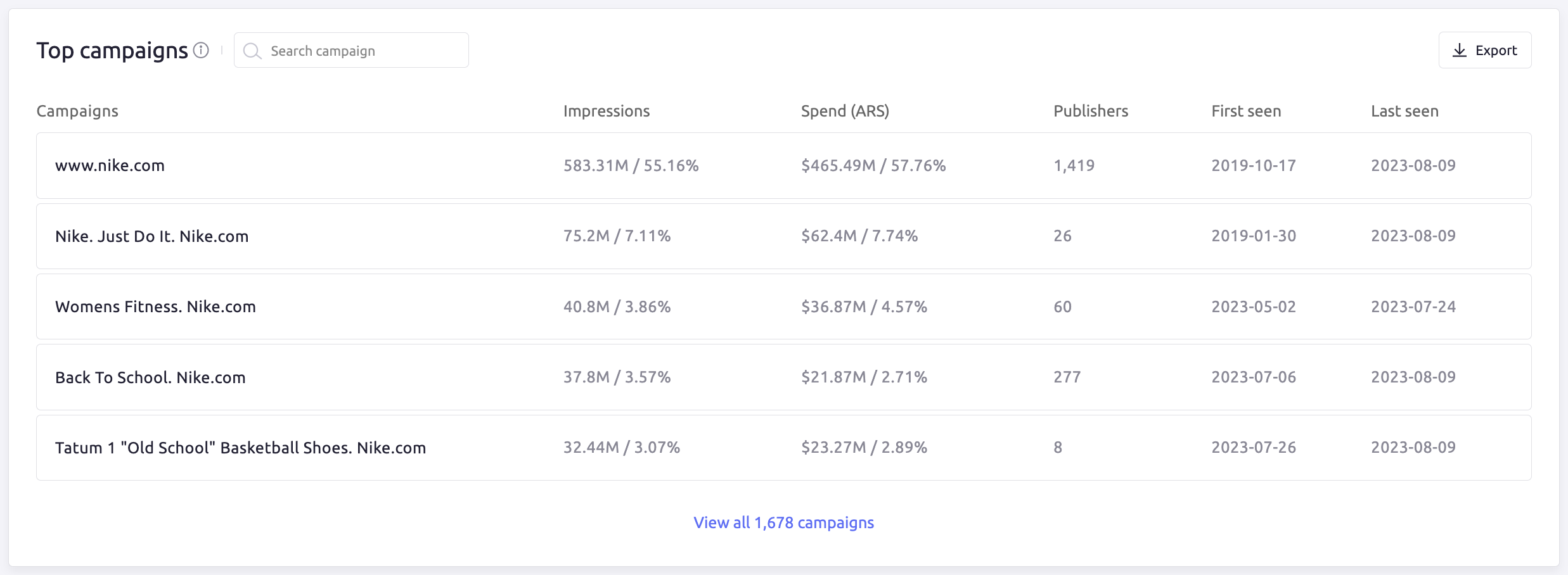
Other data included in this chart:
- Impressions
- Share of Voice (SoV)
- Ad Spend
- Number of publishers (for a single domain in Advertiser Overview only)
- Advertiser (for that specific campaign, in Publisher Overview)
Top Publishers & Top Advertisers
The Top Publishers and Top Advertisers widgets rank the best performing publishers and advertisers by impressions.
- Top Publishers: visible when analyzing an advertiser domain (also called Top Publisher & Apps when viewing all channels)
- Top Advertisers: visible when analyzing a publisher domain
When analyzing a single domain, the top five publisher domains and apps, or the top advertisers, are listed on the left side of the widget. In the center, you’ll find a breakdown of ad buying methods used for each. On the right, a pie chart displays the share of voice owned by each of the top five domains, compared to all others.
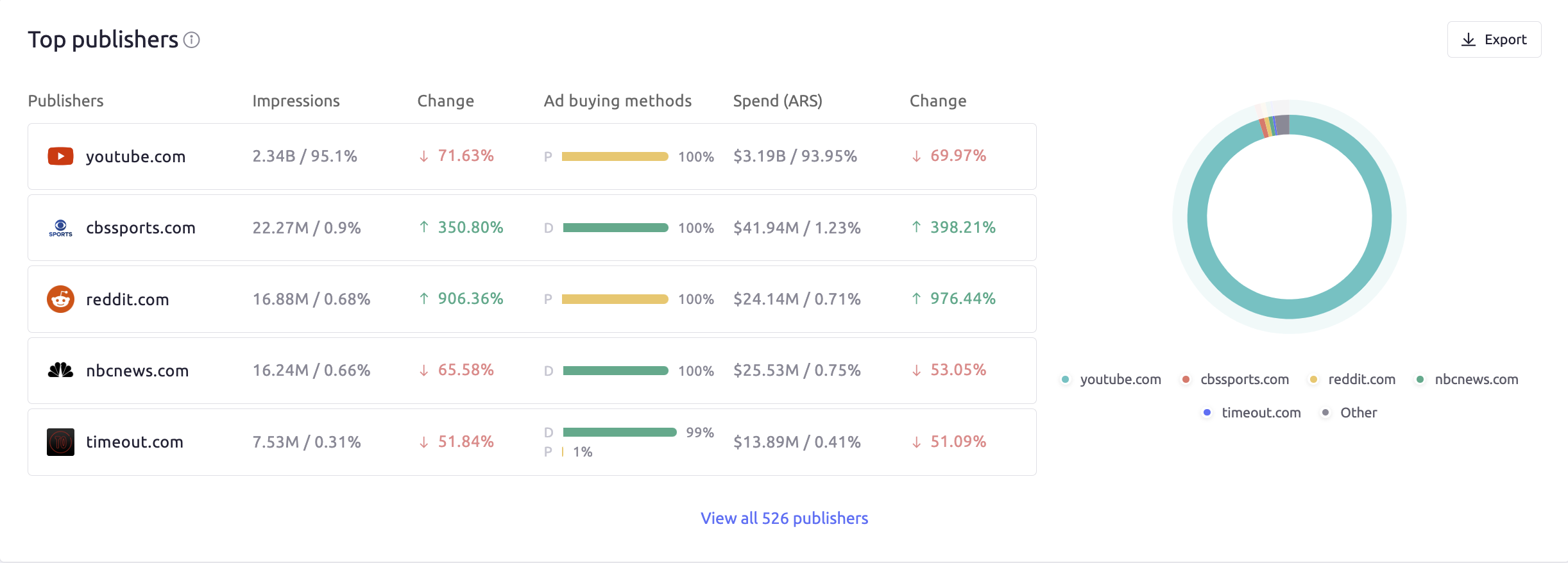
To view the complete list of top publishers or advertisers, click on the “View all” link at the bottom of the widget. A new window will open with the detailed report.
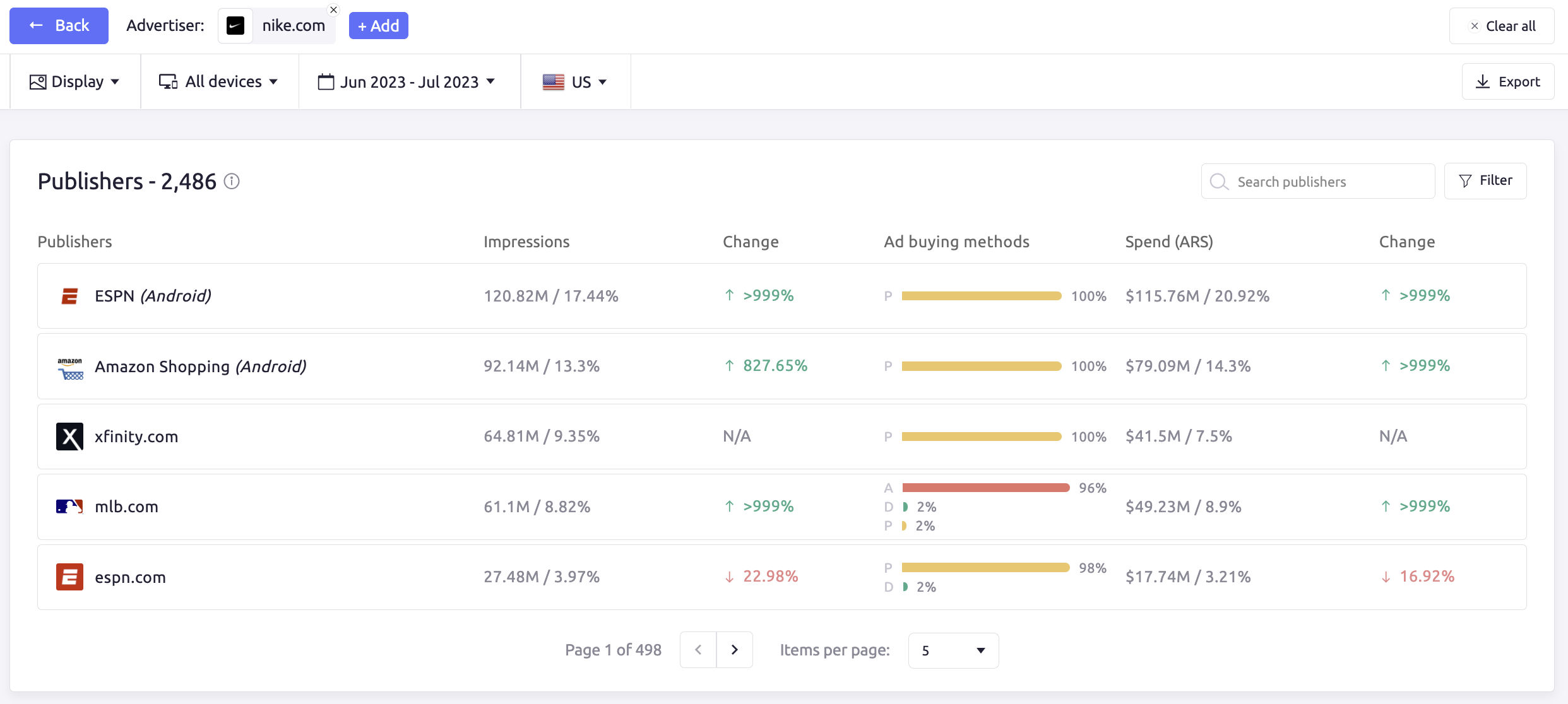
The blue Back button at the top left of the interface leads back to the original report view.
In this view, you can filter publishers by:
- Publisher type
- Impressions
- Share of Voice
- Spend
- Publishers (search by name)
Advertisers can be filtered by:
- Impressions
- Share of Voice
- Spend
- Advertiser (Search by name)
To add a filter, click on the one you’re interested in. Then, select or enter the value you want to see.
When comparing domains, the top ten domains are listed, followed by the share of voice on that domain owned by each publisher or advertiser being compared.
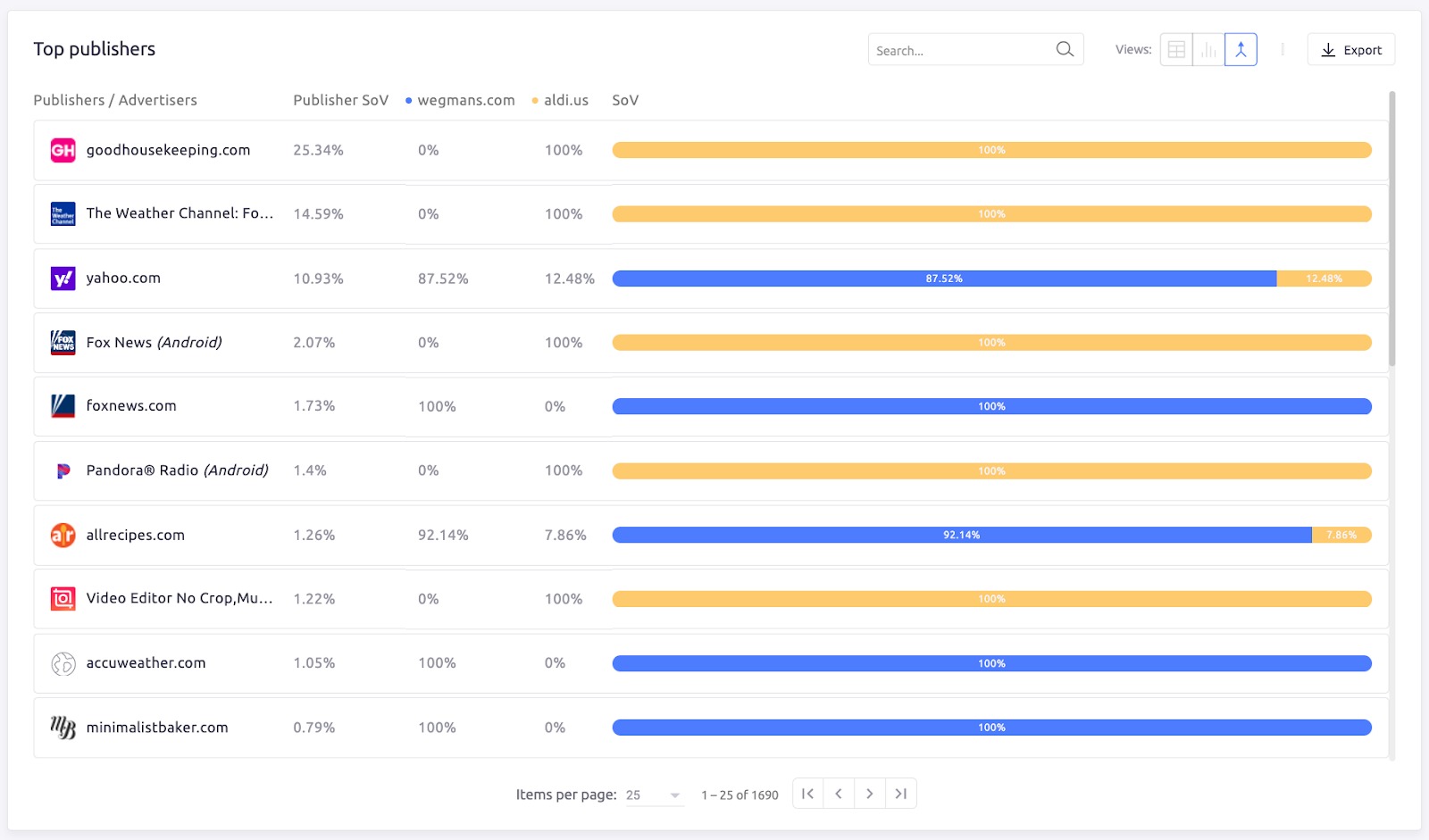
You can view this data three different ways:
- Table: displays the data numerically
- Chart: displays the data visually
- Combined: displays both
To change your view, simply click on the corresponding icon in the top right corner of the widget.
You’ll also notice that in Comparison Mode, the widget does not include a “view all” link. Instead, all publishers or advertisers are broken out into pages. You can use the page buttons at the bottom of the widget to change pages or update the amount of items per page.
If you want to learn more about a specific publisher or advertiser listed in this widget, click on its name, and you will be taken to its report.
Youtube Channels
When analyzing a single advertiser domain on the video channel, the Youtube Channels widget shows the top channels where the advertiser has placed ads. This does not appear for publishers, or when comparing two domains.
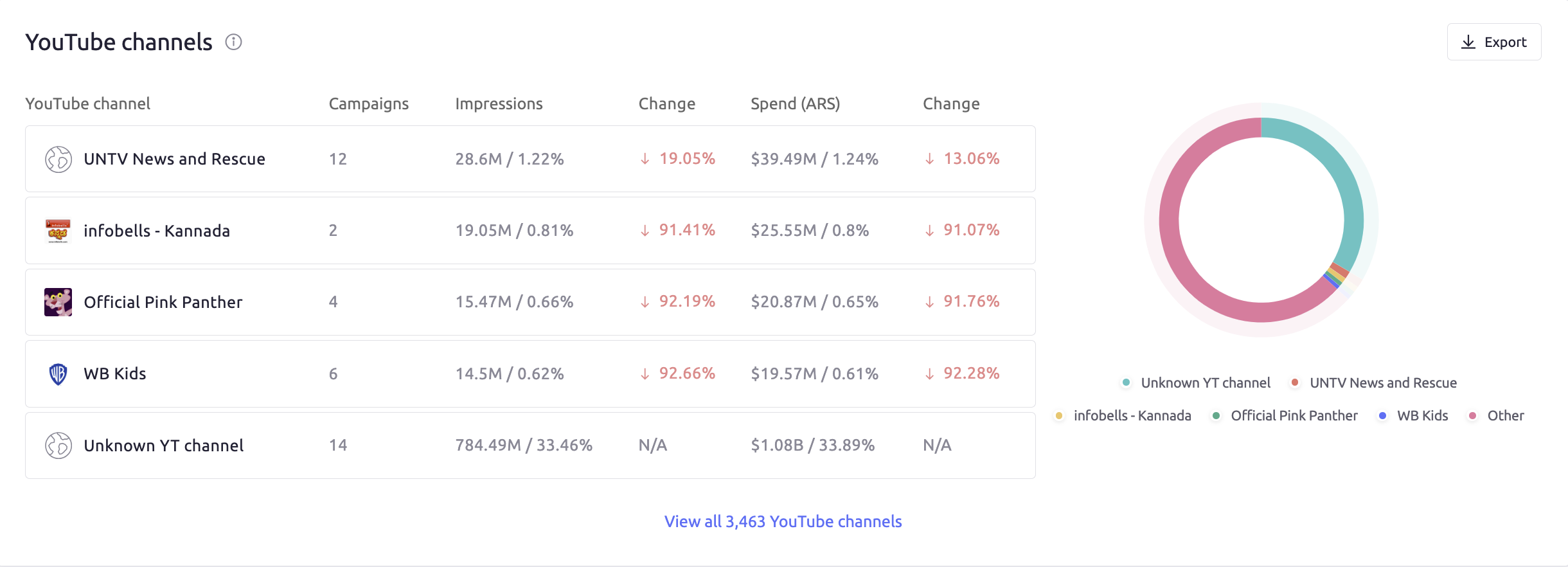
The YouTube Channels widget functions in a similar way to the Top Advertisers or Top Publishers widget. The chart includes:
- Top five channels
- Number of campaigns
- Number and share of impressions
- Value and share of advertising spend
- Share of voice breakdown
Customize your view using the dropdown menu on the right.
Click the “view all” link at the bottom to see a complete list of youtube channels where the advertiser’s ads were seen.
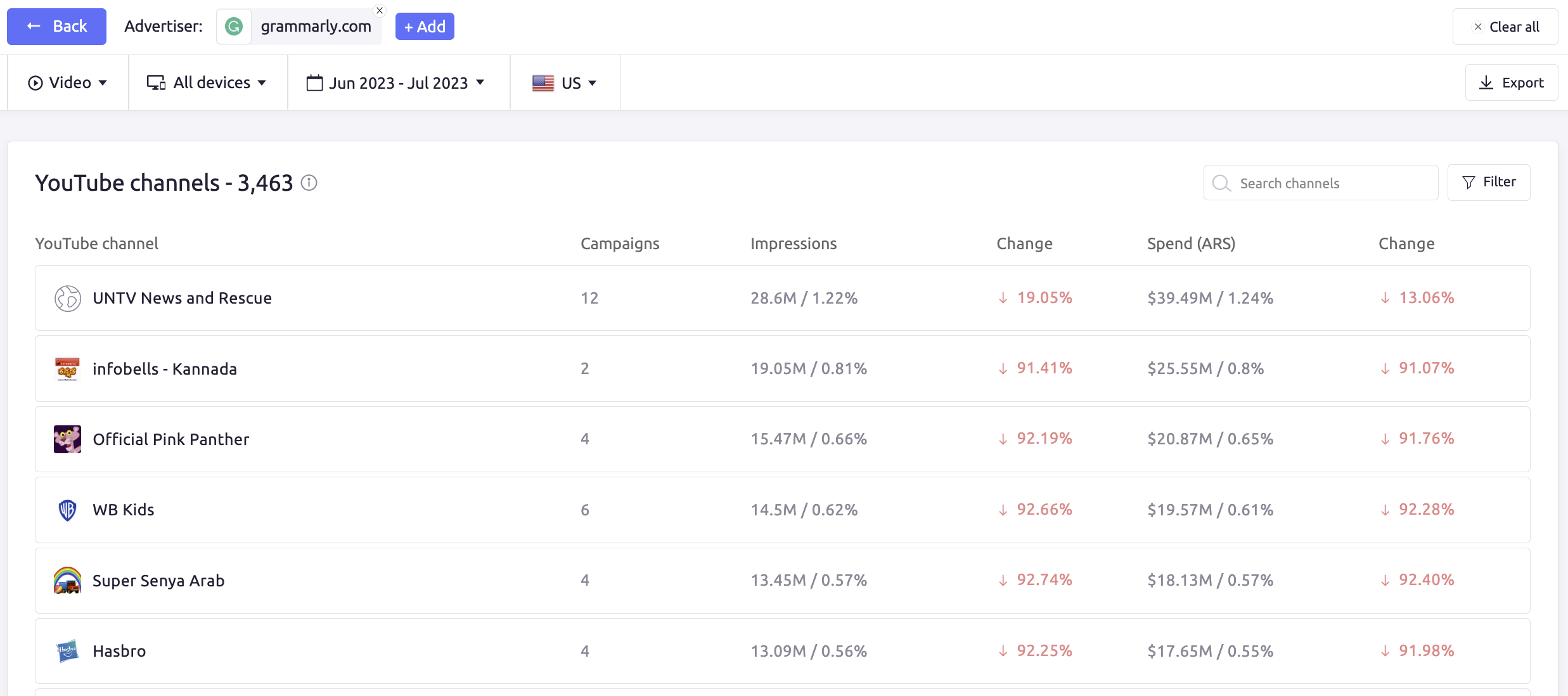
Use the drop down menu on the right to add a filter, then enter the value you’re looking for. You can filter by:
- Youtube channel name
- Campaigns
- Impressions
- Share of Voice
- Spend
Social Networks
The Social Networks widget appears when you analyze a single advertiser domain on the social channel. It shows you:
- The social platforms where the advertiser’s ads have appeared (including Facebook, Instagram, Twitter, TikTok, Pinterest and LinkedIn),
- The number and share of impressions received,
- Ad buying methods,
- Value and share of advertising spend,
- Share of voice.

Use the drop down menu on the right to customize how the values in the Impressions and Spend columns appear.
Top Apps
The Top Apps widget appears when you analyze mobile data for a single advertiser domain or group. It ranks the best performing publisher apps by ad impressions. Please note that if the selected advertiser does not promote itself on apps, this widget may not appear.

On the left side of the app, a chart breaks down the top 5 publisher apps by:
- Impressions
- Share of Voice
- Spend
- Mobile OS (e.g. Apple vs Android)
On the right, a pie chart displays the share of voice for the top 5 apps compared to all others.
To view a complete list of apps included in this report, click the “View all apps” link at the bottom of the widget. The full report can be filtered by:
- Publisher (search by name)
- Impressions
- Share of Voice
- Spend
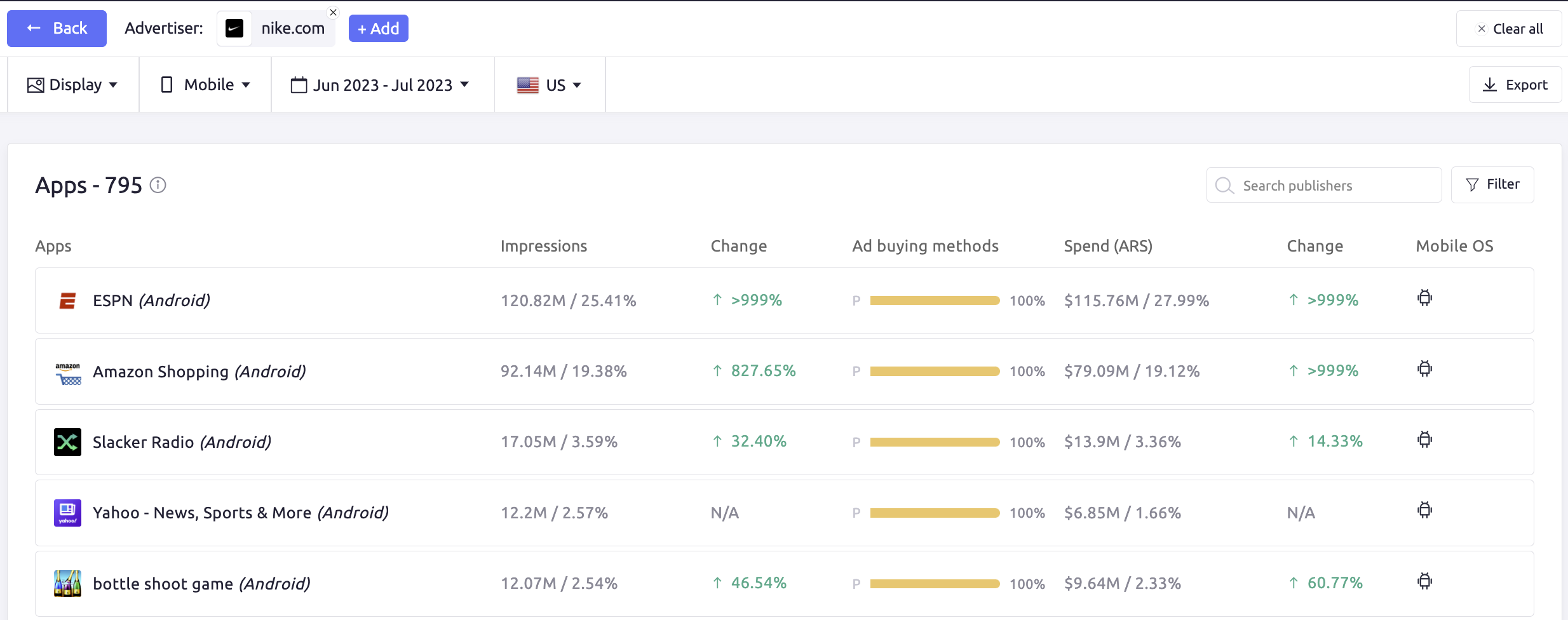
Ad Buying Methods (Full)
The second Ad Buying Methods widget shows a more detailed breakdown of the methods used by advertisers to buy ads displayed by publishers. This widget includes five different ad buying methods:
- Ad Network: Ads purchased through a network such as Google Display Network
- Programmatic: Ads purchased using an automated method, typically through an ad exchange
- Direct: Ads purchased directly through the publisher
- Programmatic/ad network: Ads purchased using a programmatic method through an ad network
- Programmatic direct: Ads purchased directly from the publisher via a programmatic method
When analyzing a single domain, this widget includes a chart on the left, breaking down the Impressions, Share of Voice, and Spend for each buying method. On the right is a pie chart that depicts the share of voice for each method.

In Comparison Mode, this widget is instead a bar graph, depicting the share of voice by buying method for each compared domain:

Channels Distribution
Available only in Comparison Mode, the Channels Distribution breaks down the distribution of display, video, and social ads for each compared domain.
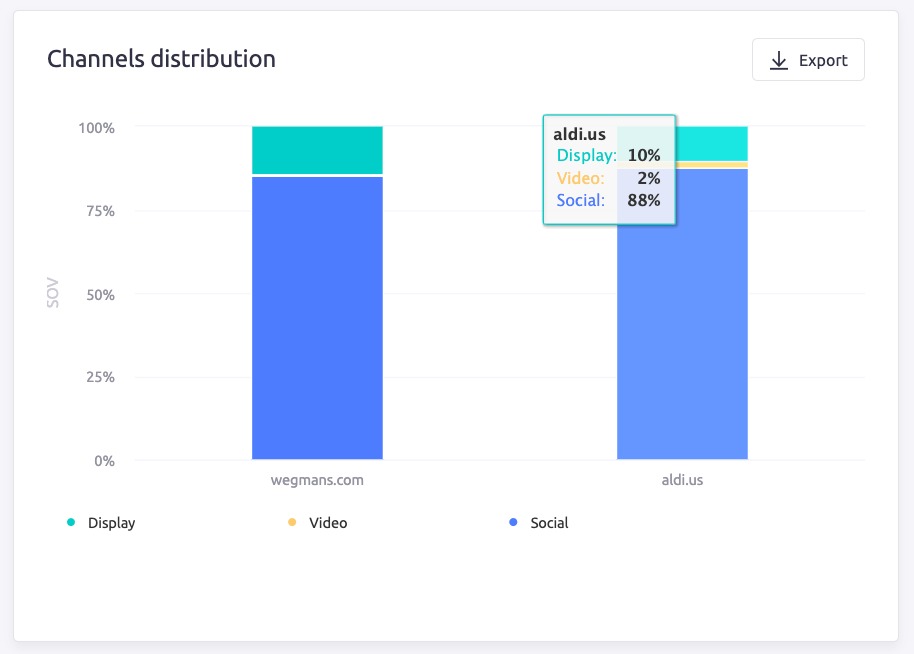
Email Notifications
With the Email Notifications functionality, you have the ability to configure Weekly or Monthly notifications for the advertisers and publishers you are subscribed to. By enabling notifications, you will automatically receive the following:
- Key performance metrics insights for top campaigns
- Highlights of creative content, allowing you to identify which ads are generating results
To start using the notifications, you need to enable them by clicking on the gear icon located in the header of the application and activating the option to receive email notifications.
Next, subscribe to the advertisers and publishers that interest you.

If you wish to subscribe to a group of advertisers or publishers, please ensure that the group has been saved beforehand.

Managing Email Notifications
To access the Email notifications menu, simply navigate to the top-right corner of the app interface.

There, you will have the ability to adjust the frequency of the updates and manage all the advertisers and publishers to whom you have subscribed.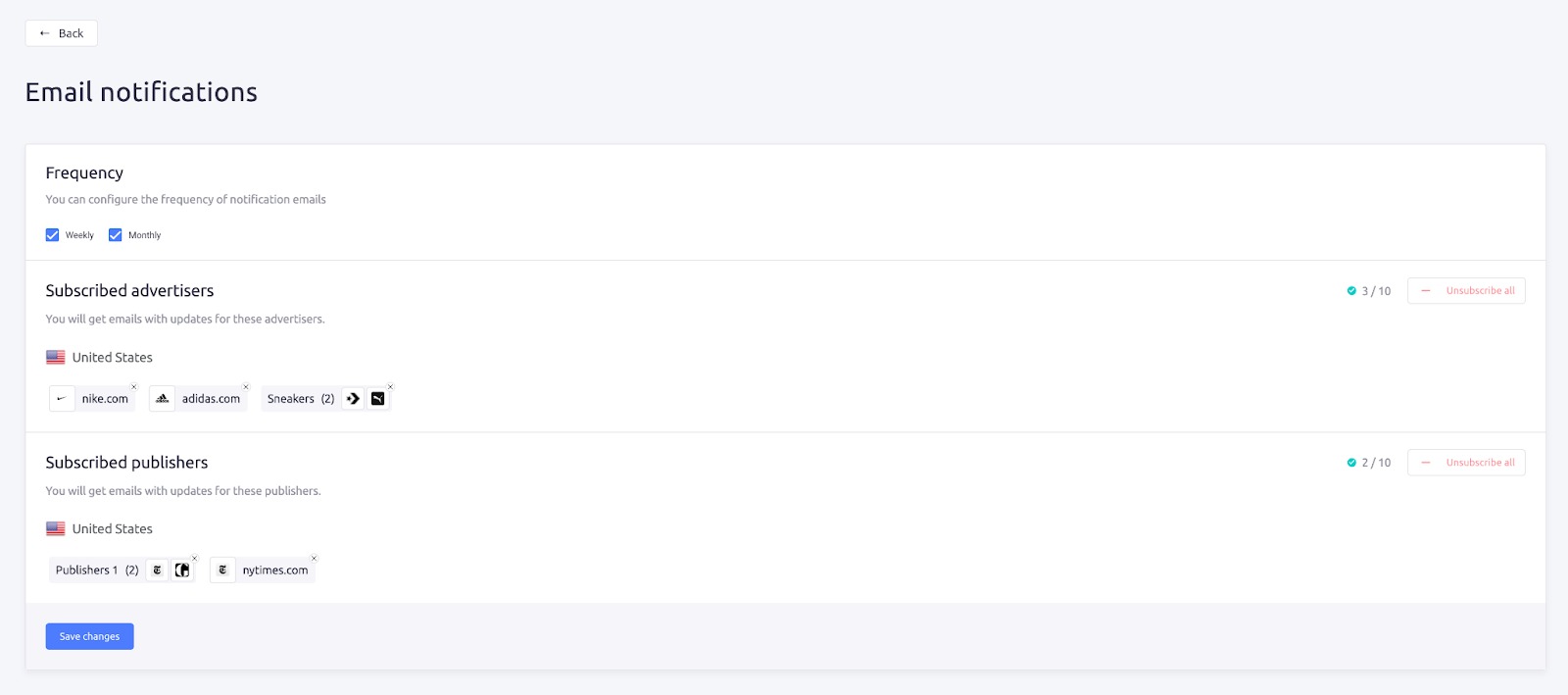
If you have other questions about the App Center or the AdClarity — Advertising Intelligence app, please email us directly at app-center@semrush.com.
Please note that the collection of LinkedIn data is still in its early stages, so its availability may vary across different countries.